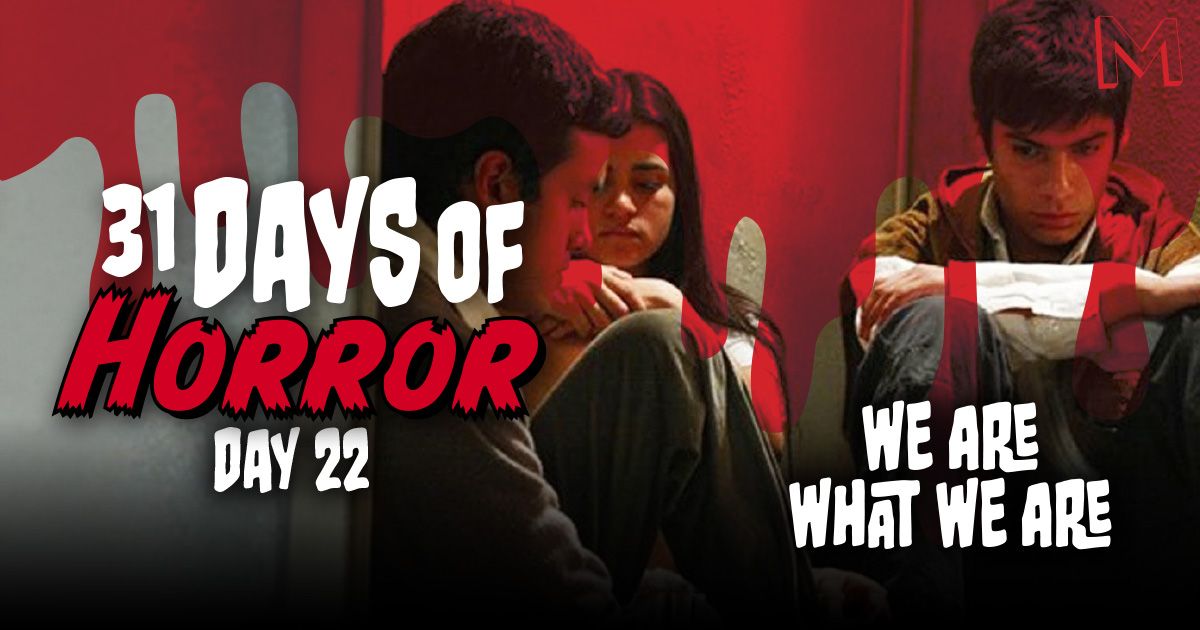
We Are What We Are: The Traditions of Family
Oct 28, 2023
Every year, horror fans and aficionados attempt to take on the daunting task of watching a horror movie for each day in the month of October. Aptly named 31 Days of Horror, the challenge usually consists of viewers watching a mixture of their favorite classics, recent releases, and popular genre staples that may be new to them. In celebration of the spooky season, we at MovieWeb have curated our own suggestions for the month, providing a plethora of favorites from our contributing writers and editors. Check out our 31 Days of Horror posts every day this October, and embrace all the freaky found footage, vicious vampires, and stalking slashers you could ever hope for. Today, we kick off Day 22 with the Mexican horror movie, We Are What We Are (2010).
Jorge Michel Grau’s Mexican film We Are What We Are (originally titled in Spanish, Somos Lo Que Hay), is a riveting and intimate view into the reality of a society whose truth lies deep within. Grau doesn’t exactly put the lens for us to analyze his comment on Mexico’s truthful circumstance.
Instead, he beautifully plans and gives you a short amount of details because some things are too intimate for us to scrutinize. Those of us outside the reality of Mexico’s poverty-stricken level of society won’t fully understand. But we’ll have enough to determine what’s important: Rules in the underbelly of the modern world are different.
We Are What We Are is, by definition, a dramatic film. One that smoothly transitions into horror, but only because of a circumstantial fact, and not because it shares anything with its peers. In the film, a traditional family follows their own traditions. They’re not the same as what you and your family practice every time you sit at the dinner table and talk about your day. Sure, they say grace, but they do so while respective their own upbringing, a ritualistic setting that’s been going on apparently for years.
Up to this point, you may wonder how a film of this nature steps into horror. Grau’s movie never denies what it is. From the beginning, the director never tries to hide what his film is actually about. He just lets the story flow delicately and accomplishes a solid rendering of social and family dynamics that feel honest, unsettling, and very personal.
We Are What We Are is a quick journey into Mexico’s underground community, crime-ridden and corruption-led. Rules are different, where they actually do exist. It just so happens that in this violent underworld, a family has managed to survive by sticking together and following a tenet that remains unbroken until death strikes.
Death Is Only the Beginning
Canana Films
We Are What We Are tells the story of a family trying to face the death of their leader and patriarch. He stumbles and falls in the middle of a shopping mall, where the cleaning crew drags his body out, and cleans the mysterious substance he threw up before his last breath.
At home, his family waits for him. Patricia, the mother, is desperate while children Alfredo, Julián, and Sabina try to hold everything together. Julián and Alfredo must take over their dad’s clock-fixing duties at the market, but they don’t even last one day. It seems the man owed money to everyone, and the boys are not welcome anymore.
Related: 15 Best Latin American Horror Movies to Watch Next
When they arrive home, Sabina confirms a body was found, and it all points to their father’s demise. All they talk about is following the ritual. For that, they will have to find something and get it, just like their father did back when he was alive, and they just waited at home. One thing’s very clear: their mother won’t provide for them. One of the children must lead the family now.
The power struggle between them, and their inability to follow up on tradition becomes the main story: they are cannibals. They must survive by finding victims, eating them, and staying true to the tradition their upbringing is based on. They never question what they’re supposed to do. It’s also not revealed whether they can consume something else. Grau doesn’t waste time by turning We Are What We Are into a film about cannibalism. This is not that kind of horror story.
Overthrowing Structures
Canana Films
Instead, Grau steps inside a claustrophobic household of dirt, blood, and ancient values, and places the camera as another family member. This is a film about a different kind of family, but a family nonetheless. Alfredo and Julián are identified as the remaining males, and for that they take it upon themselves to keep the family alive. However, they’re clumsy, confictive, and simply disagree on just about everything. Julián is volatile and addresses violence whenever he can, and Alfredo is the weakest link that can’t bring himself to perform what’s expected of him.
They each bring their own version of prey to the table. And Sabina and Patricia join this part of the discussion. Alfredo hunts in a gay club, Julián is set on seeking prostitutes, and mother Patricia seduces a taxi driver. Sabina watches as they become disgusted at their choice of what lies at the bottom of Mexico’s underbelly of society. Would the father have approved of this? Certainly not, but at this point it’s all about survival. The structure of the family is twisted enough to be broken and disarmed. They are not the same, and if they stay the same, they won’t be able to make it.
Grau never makes the mistake of looking down on his story and turning to feral displays of hunger. He insists on staying on the dramatic side of horror and shoots graphic violence as something inevitable in this raw version of Mexico’s reality. This is a way of commenting on an issue that’s extremely relevant to the film’s setting, and that will shake you to your core as you digest the film’s ethical imbalance brought upon by a rotten display of law enforcement and authority. Again, rules don’t apply. This is not your average horror film, as much as history has painted it out to be.
Is Surviving Worth It?
Canana Films
Not to say that We Are What We Are stays never fully displays its horror spirit. The third act is a wave crash that proves chaos is inevitable in this home. Improvisation has taken them here, and they will react. The ritual takes place at some point, but it’s too late. They won’t be able to stay and perform like the nucleus their leader was set on keeping together. Each one appears to have their own agenda, even a mother who doesn’t bravely stand with her children. She just runs, but justice is delivered.
The three teenagers remain while clashing with the police and themselves. Alfredo’s true nature shows up at some point, and inexplicable, he tries to eat his own sister. Julián comes to save the day, but he also becomes a victim of the whole disaster. Only Sabina remains as a survivor. Traumatized and wounded, she becomes the victim. The survivor.
Related: 25 International Horror Movies to Help Expand Your Horror Knowledge
Surviving is perhaps the worst that may happen to her. Sure, her primal side is shown in the film’s last scene, representing the fact that she will continue with the family’s tradition. But this Grau’s wink at horror-hungry audiences, and not exactly the character’s awakening and logical transformation into an animalistic being. It’s his way to feed horror audiences what they want: blood won’t be spared, at least in their minds.
However, in We Are What We Are, decency is only theoretical. This is Grau’s statement about his home country, how rotten it has remained, and how wicked mankind can be in crime-ridden underworlds. Films like this one simply portrayed a variation of something that was very real.
Death is common in this place, and secondary characters can be as peculiar as Tito the Coroner, the link that puts the film in the same universe as Guillermo del Toro’s Cronos. They will present a finding that makes their job more interesting: a human finger found in the stomach of a dead man. And they will do so while wearing a smile of fascination on their face.
Note: The film was remade in 2013 for American audiences with the same title, but it’s loosely based on the cannibalism concept and doesn’t follow the same story.
You can stream We Are What We Are on Tubi. You can follow along with our full 31 Days of Horror and watch the movies with us through our homepage and with the calendar below:
Publisher: Source link
2024 Was Quiiiiite The Year For Celebrity Breakups — Here Are 17 Couples We Lost This Year
Jennifer Lopez filed for divorce from Ben Affleck after two years of marriage.View Entire Post › Disclaimer: This story is auto-aggregated by a computer program and has not been created or edited by filmibee.Publisher: Source link
Dec 31, 2024
Rebel Wilson and Ramona Agruma Are Now Legally Married
Rebel Wilson and Ramona Agruma's marriage is aca-official. Three months after have a wedding ceremony in Italy, the Pitch Perfect star and fashion designer legally tied the knot during a second celebration in Australia that was officiated by Rebel's sister…
Dec 31, 2024
Scarlett Johansson Reacts To Colin Jost’s Dirty SNL Joke
Reacting to the video, several SNL fans thanked Scarlett for being a “great sport” as they commented on how "brutal" the jokes were.“having ScarJo there just made it 100x better,” one comment read. “Super cool of Scarlett to be such…
Dec 30, 2024
Shohei Ohtani and Wife Mamiko Tanaka Expecting First Baby
He noted that his wife is a "normal Japanese woman" who he has known for three or four years and added that he proposed to her in 2023, the outlet said. In March, a photo of Ohtani and his wife…
Dec 30, 2024











